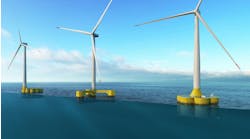Offshore staff
NORWICH, UK — A new study suggests the UK could be employing a workforce of more than 31,000 in floating offshore wind by 2040.
Opergy and the Offshore Renewable Energy Catapult’s Floating Offshore Wind Centre of Excellence (FOW CoE) published the report, basing their manning prediction on a base case deployment scenario of more than 18 GW of floating offshore wind in UK waters.
The "Floating Offshore Wind People, Skills and Vocations" project details the skills and jobs needed to develop, operate and maintain a FOW wind farm. Depending on the UK’s deployment strategy, the size of the workforce could be up to 67,000 in the high case.
Areas with shortfalls in skills and jobs are said to include development and consenting, project management, electrical and high-voltage electrical systems, various vocations associated with fabrication and advanced manufacturing, and digital skills across all areas.
The report stresses a need to minimize barriers for transitioning skills from the oil and gas sector and military to floating offshore wind, notably for marine operations and maintenance activities. The authors recommend the establishment of dedicated training centers close to ports and fabrication facilities.
Another new report, from Robert Gordon University (RGU) in Aberdeen, claims that emerging low-carbon technologies could generate 26,000 new UK energy jobs by 2030.
Most would be in the UK’s east and west coast coastal communities.
RGU’s Energy Transition Institute assessed the potential benefits of mass production of hydrogen, as a green fuel to replace natural gas and diesel; carbon transport and permanent subsurface storage of captured CO2 emissions; and electrification of offshore platforms—to reduce emissions from oil and gas production.
Offshore Energies UK (OEUK) commissioned the research as part of last year’s North Sea Transition Deal between the UK offshore oil and gas industry and the UK government.
The deal acknowledges the sector’s role in providing secure supplies of oil and gas, while at the same time delivering low-carbon energy production, including offshore wind.
RGU looked at three investment scenarios to determine how many jobs the deal might create by 2030. If the government’s British Energy Security Strategy targets were met by then, the UK would be storing 30 MM metric tons per year of CO2 underground; producing 10 GW of hydrogen (equivalent to 10 large power stations); operating 10 offshore oil or gas platforms on low-carbon electricity; and employing up to 26,000 more staff, about 15% of the entire offshore industry’s workforce.
More jobs would likely be created by activities outside the scope of offshore industries, such as CO2 capture, imports of CO2, construction of facilities, and exports of UK technology and expertise.
However, OEUK’s members must now cope with the government’s new Energy Profits Levy, which takes 65% of the profits generated from offshore oil and gas extraction to the Treasury. OEUK has warned that the levy will cost the industry at least £5 billion this year alone and risks deterring the investments needed in new technologies.
Katy Heidenreich, OEUK’s Director of Supply Chain & Operations, said electrification was the technology most affected by the new levy, but all three technologies rely on investment by offshore operators in UK energy.
“The North Sea Transition Deal has the potential to harness the expertise of our oil and gas workforce to realize the cleaner energies that will help us reach our climate goals,” she said. “To achieve the best possible outcome outlined in this study, the UK offshore energy industry needs an environment that encourages investment and acknowledges our continued need for oil and gas as new lower carbon developments and technologies come online.
“More than ever, we need long-term thinking and a political and investment environment that is predictable and stable.”
07.13.2022



